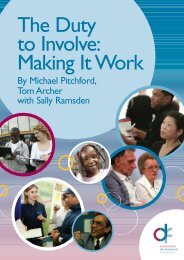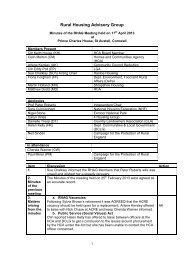Rapid Evidence Assessment of the Research ... - Rural Housing
Rapid Evidence Assessment of the Research ... - Rural Housing
Rapid Evidence Assessment of the Research ... - Rural Housing
You also want an ePaper? Increase the reach of your titles
YUMPU automatically turns print PDFs into web optimized ePapers that Google loves.
How have second homes been defined in <strong>the</strong> literature and what data sources have been used?<br />
17. The most thorough discussion <strong>of</strong> definition and data issues is in Gallent et al (2005 especially pages 6 to<br />
13). It is suggested that in <strong>the</strong> UK <strong>the</strong> debate about <strong>the</strong> definition <strong>of</strong> second homes was at its most intense in<br />
<strong>the</strong> 1970s and <strong>the</strong>y discuss a number <strong>of</strong> definitions from this decade. In particular, Gallent et al quote <strong>the</strong><br />
three-tier definition for vacation accommodation suggested by Pyne (1973). This vacation accommodation<br />
might or might not be used as a second home:<br />
1. Second home: a dwelling used by its owner and possibly o<strong>the</strong>r visitors for leisure purposes and which<br />
is not <strong>the</strong> usual permanent place <strong>of</strong> residence for <strong>the</strong> owner;<br />
2. Holiday investment property: a dwelling owned ei<strong>the</strong>r locally or outside <strong>the</strong> county and not permanently<br />
occupied but let to holiday makers solely on a commercial basis; and<br />
3. Club/institute/company holiday property: similar to above but used only by club members or company<br />
employees and clients (Pyne, 1973, p3).<br />
18. Pardoe (also quoted by Gallent et al, 2005; p7) suggested a narrower definition <strong>of</strong> a second home:<br />
“ […] a static property which is <strong>the</strong> alternative residence <strong>of</strong> a household, <strong>the</strong> principal domicile <strong>of</strong> which is<br />
situated elsewhere and which is used primarily by members <strong>of</strong> that household for <strong>the</strong>ir recreation and<br />
leisure (Pardoe, 1974).”<br />
Pardoe’s definition allowed <strong>the</strong> inclusion <strong>of</strong> static caravans but excluded touring caravans.<br />
19. Bielckus et al (1972, p9) suggest that a second homes is:<br />
“ […] a property which is <strong>the</strong> occasional residence <strong>of</strong> a household that usually lives elsewhere and which is<br />
primarily used for recreation purposes.”<br />
20. Downing and Dyer (1973, p1) followed <strong>the</strong> same definition but excluded touring caravans, boats,<br />
properties on short tenancies and properties in major cities and industrial towns.<br />
21.<br />
Shucksmith (1983, p174) used <strong>the</strong> same definition but excluded static caravans.<br />
22. Gallent et al (2005) note that <strong>the</strong> distinction between built second homes and static caravans is now<br />
clearly defined in much <strong>of</strong> <strong>the</strong> literature and in <strong>the</strong> Survey <strong>of</strong> English <strong>Housing</strong> (see below).<br />
23.<br />
A report for The Countryside Agency (2002a, pp14-15) suggest that second homes are:<br />
“Privately owned dwellings mainly used for vacations: <strong>the</strong>y are furnished homes that are no-one’s main<br />
residence.” They make a distinction between:<br />
1. Second home: a dwelling used by its owner and possibly o<strong>the</strong>r visitors for leisure or holiday purposes<br />
and which is not <strong>the</strong> usual or permanent place <strong>of</strong> residence for <strong>the</strong> owner; and<br />
2. Holiday investment property (Holiday Home); a dwelling owned ei<strong>the</strong>r locally or outside <strong>the</strong> area and not<br />
permanently occupied but let to holiday makers solely on a commercial basis.<br />
24. It is suggested that <strong>the</strong>se two categories <strong>of</strong> property raise different issues and may introduce different<br />
impacts. “We might suggest that private and business owners will purchase different types <strong>of</strong> property<br />
(affecting <strong>the</strong> housing market in different ways) or use accommodation in different ways (affecting <strong>the</strong> particular<br />
mix <strong>of</strong> social or economic impacts). It follows <strong>the</strong>n that future assessments <strong>of</strong> <strong>the</strong> number <strong>of</strong> second homes (at<br />
any level) should take into account <strong>the</strong> varying mix <strong>of</strong> <strong>the</strong>se second home types” (ibid, p15).<br />
15






